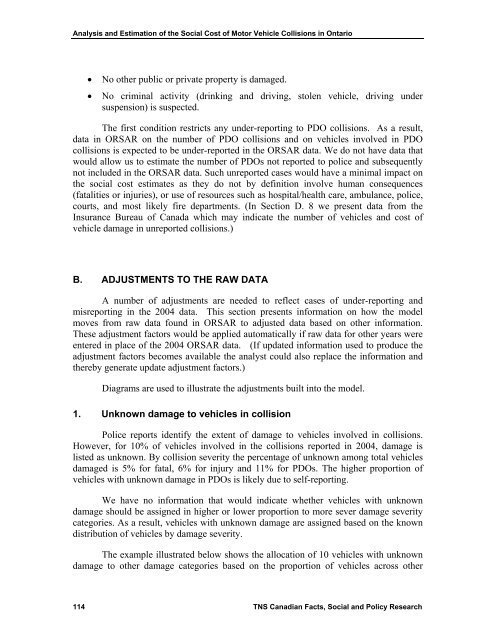Keith Vodden Dr. Douglas Smith - Transports Canada
Keith Vodden Dr. Douglas Smith - Transports Canada
Keith Vodden Dr. Douglas Smith - Transports Canada
Create successful ePaper yourself
Turn your PDF publications into a flip-book with our unique Google optimized e-Paper software.
Analysis and Estimation of the Social Cost of Motor Vehicle Collisions in Ontario<br />
• No other public or private property is damaged.<br />
• No criminal activity (drinking and driving, stolen vehicle, driving under<br />
suspension) is suspected.<br />
The first condition restricts any under-reporting to PDO collisions. As a result,<br />
data in ORSAR on the number of PDO collisions and on vehicles involved in PDO<br />
collisions is expected to be under-reported in the ORSAR data. We do not have data that<br />
would allow us to estimate the number of PDOs not reported to police and subsequently<br />
not included in the ORSAR data. Such unreported cases would have a minimal impact on<br />
the social cost estimates as they do not by definition involve human consequences<br />
(fatalities or injuries), or use of resources such as hospital/health care, ambulance, police,<br />
courts, and most likely fire departments. (In Section D. 8 we present data from the<br />
Insurance Bureau of <strong>Canada</strong> which may indicate the number of vehicles and cost of<br />
vehicle damage in unreported collisions.)<br />
B. ADJUSTMENTS TO THE RAW DATA<br />
A number of adjustments are needed to reflect cases of under-reporting and<br />
misreporting in the 2004 data. This section presents information on how the model<br />
moves from raw data found in ORSAR to adjusted data based on other information.<br />
These adjustment factors would be applied automatically if raw data for other years were<br />
entered in place of the 2004 ORSAR data. (If updated information used to produce the<br />
adjustment factors becomes available the analyst could also replace the information and<br />
thereby generate update adjustment factors.)<br />
Diagrams are used to illustrate the adjustments built into the model.<br />
1. Unknown damage to vehicles in collision<br />
Police reports identify the extent of damage to vehicles involved in collisions.<br />
However, for 10% of vehicles involved in the collisions reported in 2004, damage is<br />
listed as unknown. By collision severity the percentage of unknown among total vehicles<br />
damaged is 5% for fatal, 6% for injury and 11% for PDOs. The higher proportion of<br />
vehicles with unknown damage in PDOs is likely due to self-reporting.<br />
We have no information that would indicate whether vehicles with unknown<br />
damage should be assigned in higher or lower proportion to more sever damage severity<br />
categories. As a result, vehicles with unknown damage are assigned based on the known<br />
distribution of vehicles by damage severity.<br />
The example illustrated below shows the allocation of 10 vehicles with unknown<br />
damage to other damage categories based on the proportion of vehicles across other<br />
114 TNS Canadian Facts, Social and Policy Research
















